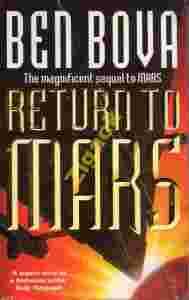 |
Return to Mars
Ben Bova
NEL London 1999
stan dobry
str. 548
format 11 x 18 cm
waga 320 g
In 1992, Ben Bova sent a Navaho, Dr. Jamie Waterman to Mars. While there, Waterman helped discover Martian lichen and may have seen evidence of a artificial city built into the wall of the Tithonium Chasm. In 1999, both Bova and Waterman Return to Mars to discover if the city actually exists or if Waterman was merely seeing things in the Martian dust. When Waterman goes back to Mars, he finds himself in charge of the expedition instead of merely a late addition.
Bova makes it clear early in the novel that things are going to go wrong. Interspersed with the narrative chapters are the excerpts from an unidentified mission diary which indicates that at least one of the eight members of the team is psychologically unstable. The clues Bova drops quickly allow the reader to rule out certain members of the mission, although not select any character as the author of the diary. While the reader waits for the revelation of the author, Bova provides plenty of scientific exploration and political hijinks to keep the reader riveted.
Waterman’s nemesis on this mission is Dex Trumball, the son of the chief financier for the expedition. Like Waterson, Trumball is a trained geophysicist. Unlike Waterman, Trumball has maintained his credentials in the field as he built his reputation. While Waterman sees Mars as a primal land which should be held sacred, Trumball sees the money-making potential for the planet as his only chance to receive his father’s approval. In addition to dealing with the younger Trumball, Waterman must deal with the tirades of the father who isn’t ready to admit that Dex is a grown and responsible man.
Political problems are only the beginning as the expedition members must deal with injuries and dust storms which rage over the surface of the planet for weeks at a time. While Waterman and his colleagues can use their personalities and intelligence to iron out their own differences, the natural problems of Mars must be allowed to run their own course.
Eventually, of course, Waterman must face his own bugbears and attempt to find the ancient city that only he really believes in. Bova plays this quest well, downplaying it throughout the novel until Waterman is ready to go in search for it. Early reconnaissance missions give an indication that the city isn’t there. It does become apparent that even if they city doesn’t physically exist, its spiritual existence is as important to Waterman as anything else on Mars.
Bova seems to be determined to make his various series mesh together, much as Isaac Asimov did in the 1980s. Return to Mars contains references to Bova’s "Sam Gunn" stories as well as his "Moonbase" series. Because Bova’s references are simply fleeting, and don’t need to be fully integrated into his story. One major effect is the use of the island Tarawa in Kiribati as the mission control for the Mars mission. This is the same location used in the "Moonbase" series, although the nanomachine issue which "Moonbase" deals with is notably missing from Return to Mars. An indication, perhaps, of the separate origins of the two series.
Bova’s Return to Mars is firmly grounded in hard science, much as Kim Stanley Robinson’s "Mars Trilogy." Unlike the Robinson, Bova is more interested in the research possibilities and the practices which will make exploration of the fourth planet possible, rather than the idea of terraforming the planet and using it for a political laboratory. When Bova’s Mars was first published in 1992, it was among the best of the Mars novels which were published in the early 90s (Beachhead, Labyrinth of Night, Mars Prime, Red Mars, etc.) and Return to Mars continues the story at the same high level.
www.sfsite.com
|
|
|
|
|
 |

